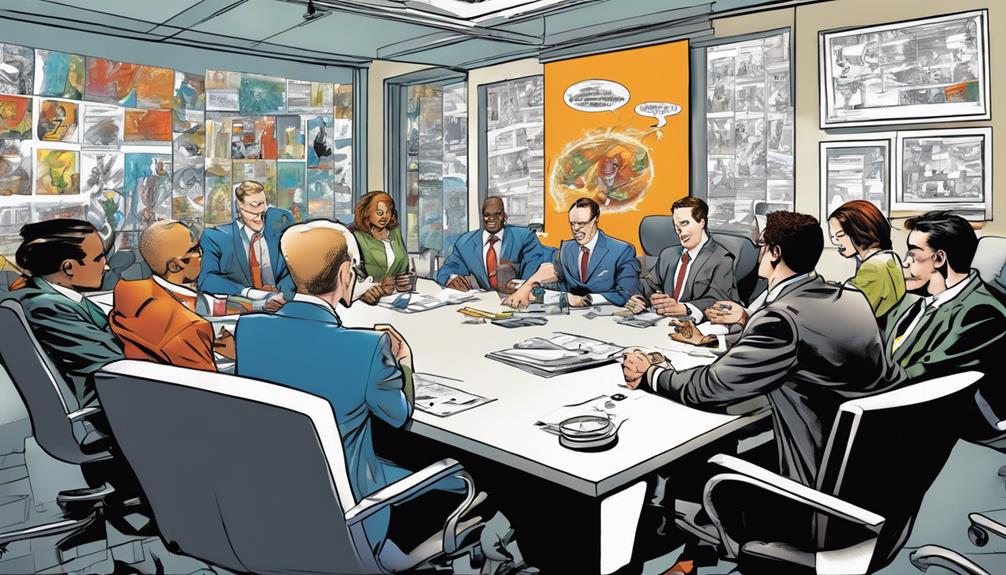To discover top mentorship hot spots, start by exploring co-working spaces and incubators, which spark collaboration and offer essential resources. Attend local networking events and community meetups to connect with like-minded professionals. Online platforms like LinkedIn and SCORE provide additional mentoring and support tailored to your needs. Engage with small business development centers for personalized guidance and industry conferences for networking with potential mentors. Finally, consider volunteering to expand your connections. Each of these avenues can enrich your entrepreneurial journey and lead to significant growth opportunities. There's so much more to uncover, so keep going! Building a culture of innovation is crucial for success in the entrepreneurial world. Seek out mentors who have a track record of fostering creativity and thinking outside the box. Surround yourself with individuals who challenge conventional wisdom and are passionate about driving change. By tapping into these mentorship hot spots, you can accelerate your journey towards building a culture of innovation within your own business or organization.
Key Takeaways
- Co-Working Spaces: These environments promote collaboration and allow entrepreneurs to connect with peers and mentors in a dynamic setting.
- SCORE Mentoring: Access over 11,000 experienced mentors through local chapters, offering personalized guidance and support for entrepreneurs.
- Incubators and Accelerators: These programs provide resources, mentorship, and funding opportunities to help startups grow and succeed.
- Small Business Development Centers: Receive tailored advice, training programs, and networking opportunities from professionals familiar with local markets.
Networking Events
Networking events offer you a dynamic platform to connect with like-minded professionals and expand your entrepreneurial network.
These gatherings are designed for building relationships, so approach conversations casually instead of aggressively pursuing goals. Focus on engaging with multiple attendees, as you never know who might spark a potential partnership.
Seek out local and industry-specific events to maximize your relevance and impact. Remember, it's not just about immediate outcomes; nurturing connections can lead to future collaborations.
Exchange ideas, share experiences, and be open to learning from others. By fostering these relationships, you create a supportive network that can guide you through the entrepreneurial journey.
Embrace each opportunity to meet new people and grow your business connections.
Entrepreneur Hot Spots

Identifying vibrant local areas with thriving startup cultures can greatly enhance your entrepreneurial journey. These entrepreneur hot spots provide a supportive environment where you can connect with like-minded individuals, share ideas, and access valuable resources.
Here are three key places to explore:
- Co-Working Spaces: These hubs foster collaboration and creativity, allowing you to network with other entrepreneurs.
- Incubators: Look for local incubators that offer mentorship, resources, and funding opportunities to help you scale your business.
- Community Meetups: Attend meetups or brainstorming sessions to engage with fellow entrepreneurs and gain fresh perspectives.
Online Platforms

Online platforms have become essential tools for entrepreneurs seeking mentorship and support in today's digital landscape.
You can leverage LinkedIn to connect with industry professionals and potential mentors by engaging with their content and initiating casual conversations.
Twitter's informal nature allows you to introduce yourself to thought leaders and participate in discussions relevant to your field.
Platforms like SCORE offer free mentoring sessions from experienced volunteers, while specialized forums can connect you with peers who share similar challenges.
Don't underestimate the power of online communities; they can lead to valuable relationships and insights.
Small Business Development Centers

Small Business Development Centers (SBDCs) offer a wealth of resources and expertise that can greatly benefit emerging entrepreneurs. You'll find free consultations to help you refine your business strategies and access workshops designed to enhance your skills.
Here are three key advantages of utilizing SBDCs:
- Tailored Guidance: Get personalized advice from professionals who understand your local market.
- Training Programs: Participate in workshops that cover essential topics like marketing, finance, and management.
- Networking Opportunities: Connect with other entrepreneurs and local resources that can support your business growth.
SCORE Mentoring

SCORE mentoring connects you with experienced volunteers who can guide you in starting and growing your business. With over 11,000 mentors across 320 chapters nationwide, SCORE provides personalized support tailored to your needs. You'll benefit from free face-to-face meetings, workshops, and resources designed to enhance your business knowledge. Whether you're seeking short-term advice or a long-term mentorship, SCORE's extensive network can help you navigate the entrepreneurial landscape.
| Benefits of SCORE Mentoring | Description |
|---|---|
| Experienced Mentors | Access to industry professionals |
| Free Support | No cost for consultations |
| Networking Opportunities | Connect with local entrepreneurs |
| Workshops | Enhance skills and knowledge |
| Long-Term Relationships | Build lasting mentorship ties |
Industry Conferences

Why attend industry conferences? They offer invaluable networking opportunities and insights directly from experienced professionals in your field. At these events, you can connect with like-minded entrepreneurs and gain knowledge that can propel your business forward.
Here are three reasons to prioritize industry conferences:
- Networking: Meet potential mentors and partners who can guide your entrepreneurial journey.
- Workshops: Participate in hands-on sessions that provide practical skills and industry-specific knowledge.
- Trends: Stay updated on market trends and innovations that could impact your business strategy.
Community Engagement

Engaging with your community regularly can reveal a wealth of mentorship opportunities and valuable connections for your entrepreneurial journey.
Volunteering is a great way to meet diverse individuals while making a positive impact. You'll naturally network in these settings, learning from experienced professionals who might become mentors.
Attend local events or gatherings to immerse yourself in your community, and don't hesitate to leverage your personal network of friends and family. They might know successful entrepreneurs who can provide guidance.
Additionally, consider indirect competitors; they can offer insights without direct competition.
Stay open to new experiences and conversations—every interaction could lead to a valuable connection that enhances your entrepreneurial path.
Embrace community engagement as a key strategy for growth.
Conclusion
In your quest for mentorship, remember that opportunities abound in unexpected places.
By immersing yourself in networking events, entrepreneur hubs, and online platforms, you're bound to connect with seasoned professionals who can illuminate your path.
Don't underestimate the power of local resources like Small Business Development Centers and SCORE mentoring.
Embrace these experiences, and you'll find that the right guidance can be a game-changer.
So, venture forth and seize these golden opportunities—your entrepreneurial future awaits!









